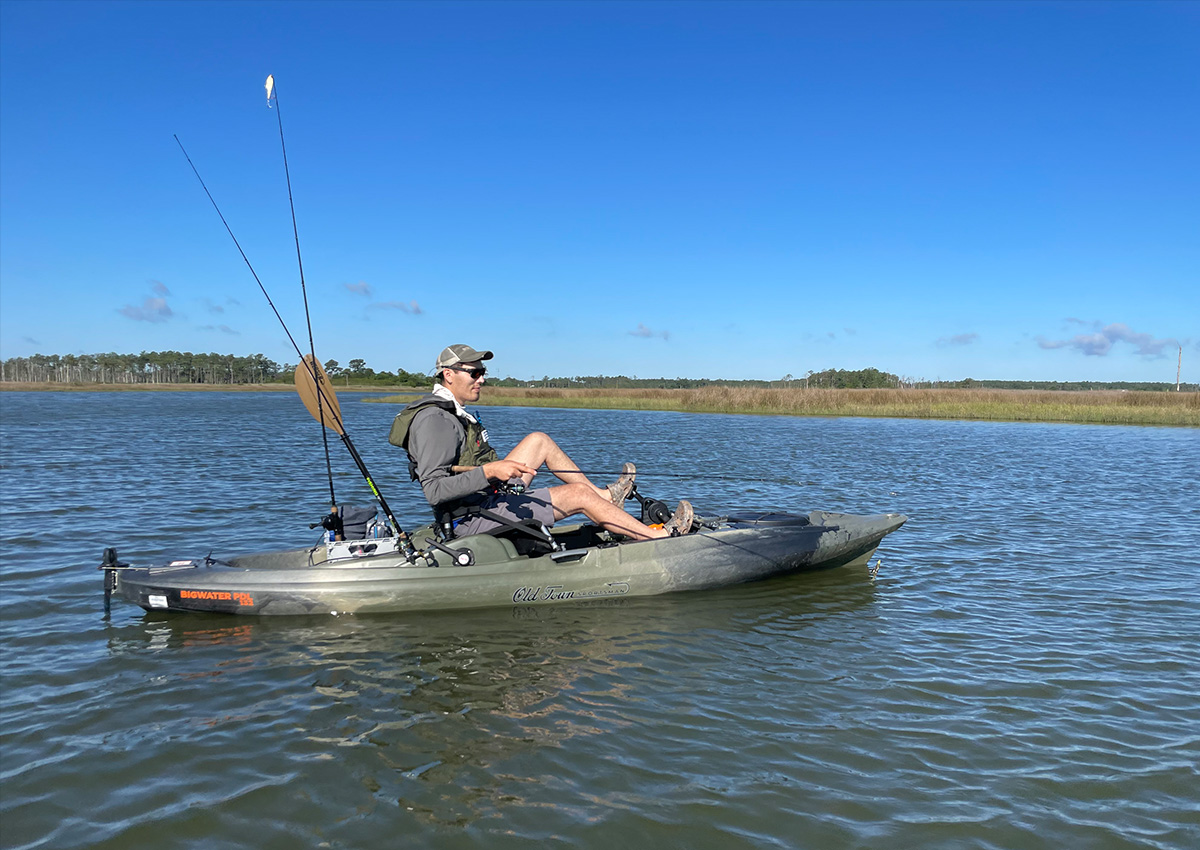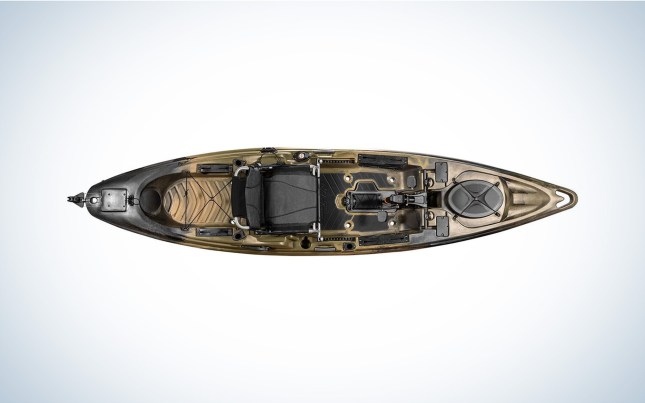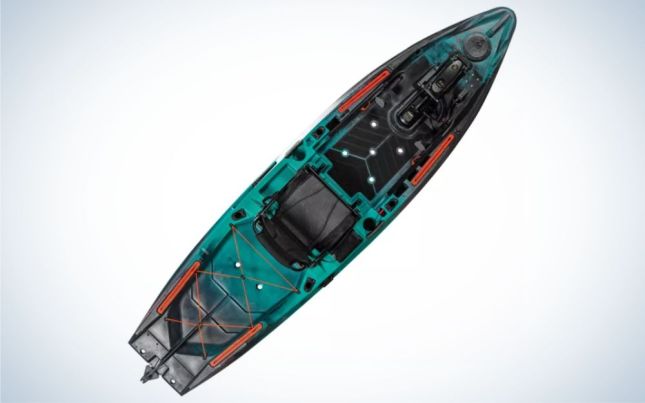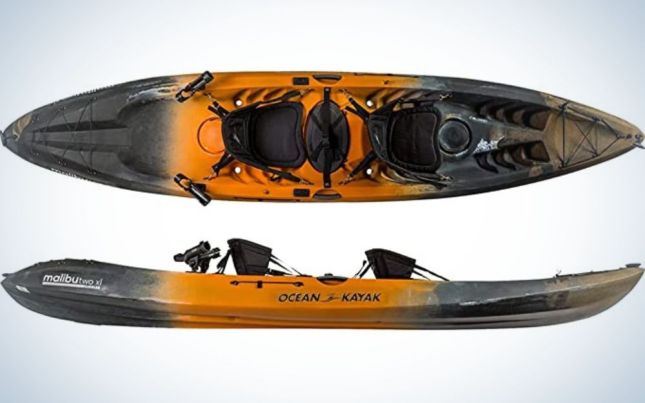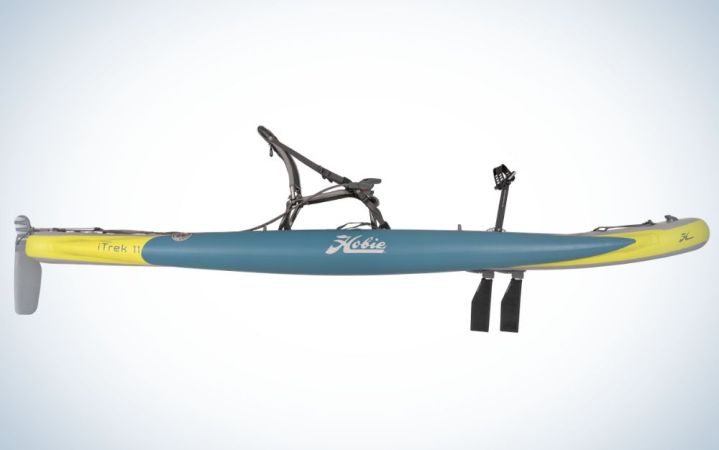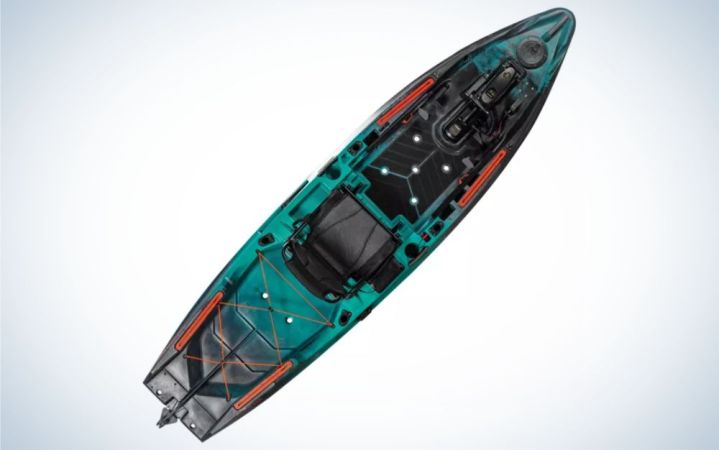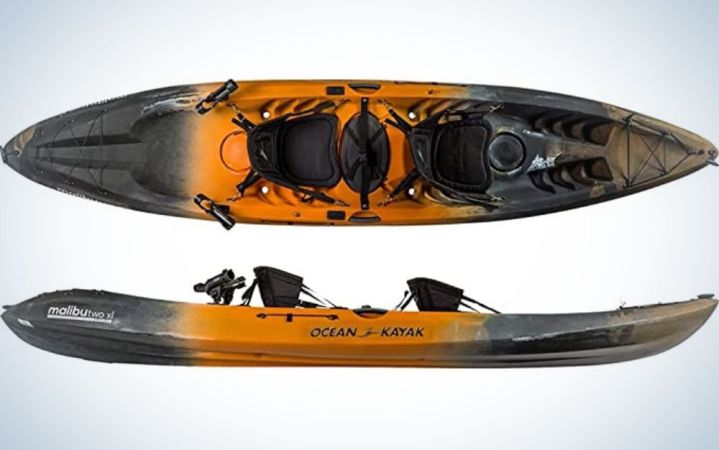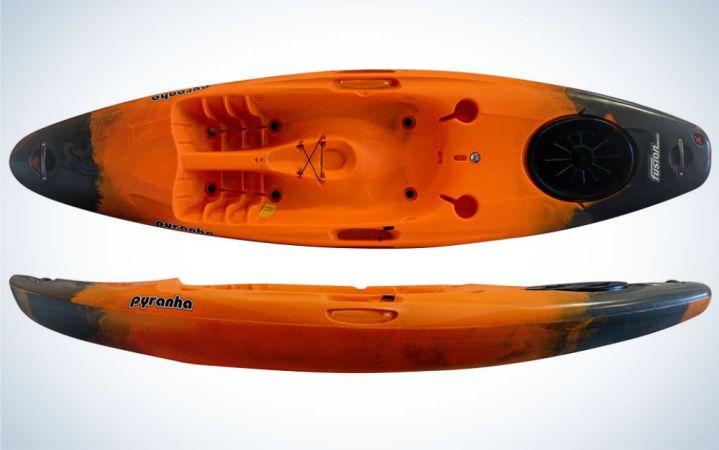We may earn revenue from the products available on this page and participate in affiliate programs. Learn More ›
Simplicity and freedom: Two key attributes promised by a good sit-on-top kayak—they’re simple to transport and launch from almost any point at which you can access the shore of a lake, river, bay, or beach, and offer the freedom to go nearly anywhere on any water. And (although there are some nifty motorized options for anglers) you can do it all on your own, under your own power.
While some of the more sophisticated kayaks may cause some very understandable sticker shock, they can last for years and years with minimal maintenance, and many outstanding SOT kayaks are priced within reach. To find the standouts I talked to kayak experts throughout the country about their preferred kayaks. Below are six of the best sit-on-top kayaks for different use cases.
- Best for Coastal and Open-Water Fishing: Old Town Sportsman Bigwater PDL
- Best Inflatable: Hobie Mirage ITrek II
- Best Motorized: Old Town Sportsman AutoPilot 120
- Best Tandem: Ocean Kayak Malibu Two XL
- Best for Inshore and Lake Fishing: Hobie Mirage Pro Angler 12 360
- Best for Rivers: Pyranha Fusion SOT
How to Choose a Sit-on-Top Kayak
A surprising array of considerations await anyone contemplating a new kayak purchase. Some things to think about once you know how and where you plan to use your kayak:
Length
In fishing kayaks 101 you’ll learn that, in general, longer kayaks are faster and shorter kayaks are slower—but not necessarily “slow.” Shorter yaks also offer better, quicker maneuverability. Also shorter hulls are likely to be lighter. A longer kayak tracks better than a shorter one, which means as you paddle, there is less left to right shift with each stroke.
Width
Narrow kayaks are faster. However, again, there are the “buts”: But wider, while a bit slower to paddle or pedal, also means more stability and most kayakers appreciate that. In years past, long and narrow SOTs were popular for long-distance touring, but few manufacturers offer these now.
Weight
Yet again, there are tradeoffs. As a rule, more weight means more kayak, typically with more features and accessories (notably here we’re talking the best fishing kayaks). Smaller hulls devoid of many accessories will be lighter. Also, weight can be a factor in performance: Lighter hulls tend to be more maneuverable; heavier hulls may track better while underway. Kayaks over 130 pounds are difficult for one person to load and unload by themselves.
Material
There’s not a great deal of significant variation from yak to yak here: Most are roto-molded polyethylene—tough stuff—though some are high-density poly which can be lighter and stronger but also cost more.
Capacity
How many pounds is a kayak rated to carry? That includes kayaker(s) and gear. Often this isn’t a concern, but particularly larger kayakers and/or those who have reason to gear up heavily should check the specs on this (and ensure any kayak purchased has considerably more capacity than you’ll use; never load a kayak beyond 75 to 80 percent of its rated capacity). Some larger kayaks are rated for as much as 500 pounds or more.
Seat
Anyone who spent some hours in a kayak can appreciate the importance of the seat. Seats vary greatly, from simple basic backrests — which can be just fine for brief outings—to fully adjustable, ergonomic stadium-type seats. Backrest seats can be preferable for serious paddling since they offer one’s torso a much better range of motion. But for more relaxed paddling and especially for those sitting for hours, a larger, adjustable, comfortable seat with lumbar support can make all the difference. These do of course, add a bit more weight to the kayak.
Rudder
Most SOTs now either include a rudder or offer it as an option. Is a rudder essential? No, but it’s a great option. Paddlers rely on them to expend more energy moving ahead vs. trying to also keep their steerage on track with each stroke. For pedal power kayaks, a rudder is critical. It’s worth looking at the design, as some operate more reliably than others.
Storage
Some kayaks offer little or no storage, so consider the options depending on how much gear you want to take. Some (especially on fishing-designed kayaks) offer extensive waterproof stowage beneath hatches.
Amenities/Accessories
Again, some SOTs are bare-bones and may have limited allowances for accessorization, whereas many come with many built-in features and are set up for ease of further accessorization—from light and simple to heavy and loaded, it all depends on the buyer’s use and preferences.
Best Sit-on-Top Kayaks: Reviews & Recommendations
Best for Coastal and Open-Water Fishing: Old Town Sportsman Bigwater PDL
Key Features
- Length: 13 feet, 2 inches
- Width: 36 inches
- Weight: 95 pounds (hull only). 122 pounds including hardware, seat, pedal console
- Capacity: 378 pounds
- Accessories: PDL Drive, adjustable seat, forward and aft mounting tracks, universal transducer mounting system, three flush-mounted rod holders, dry box built into the pedal drive, three color options
Pros
- Instant forward or reverse
- Easy to fully rig
- Five-year pedal-drive warranty
Cons
- Pedal drive has some play while pedaling
Expert Profile: Scott Einsmann is a longtime kayak-fishing enthusiast who uses his kayak to target coastal gamefish such as redfish, speckled trout and striped bass, as well as bass, snakeheads, and crappie throughout Virginia. Einsmann’s kayak of choice for fishing inshore, lakes, and rivers is the Old Town Sportsman Bigwater PDL 132. Based on the hugely successful Predator hull, Old Town’s Bigwater 132 PDL offers new features and innovations to make it an outstanding hands-free fishing machine.
Old Town has created a versatile fishing kayak with what Einsmann calls a happy medium in hull design that is effective for fishing coastal shallows or open water farther offshore. “It’s great for long runs across a large bay, offering good speed while maintaining stability,” he says. Einsmann also cites the pedal-drive system’s reliability as critical. “If your pedal drive goes down, your fishing day is done as you limp home using your paddle,” he said. The Bigwater’s large hull can be paddled well enough, but not easily or efficiently.
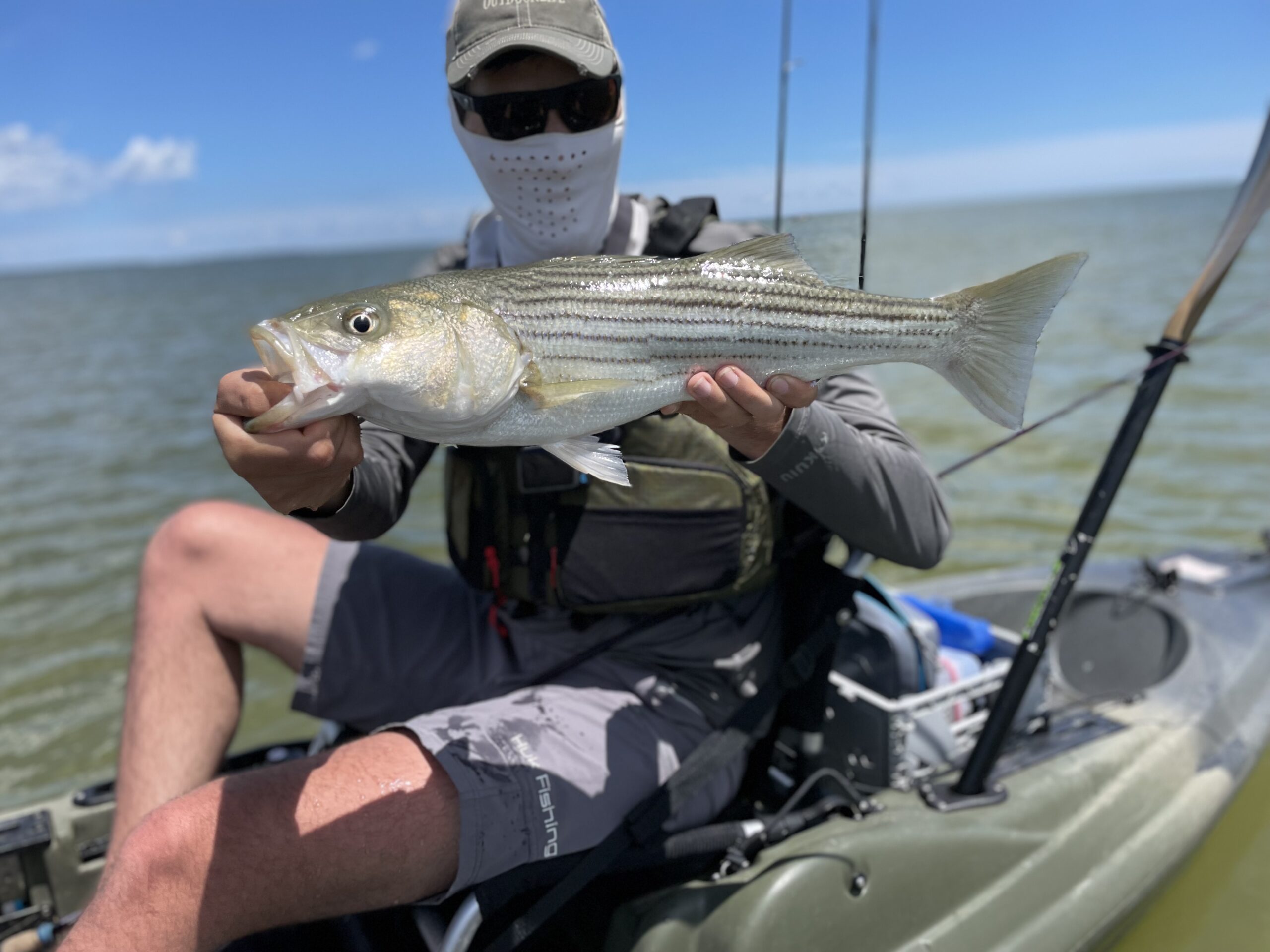
The Old Town pedal drive can handle the abuse and corrosion inherent in saltwater fishing. That pedal drive, which Einsmann reports is smooth and responsive, is not simply great for getting from point A to point B with leg power, but also offers instant reverse with no levers to flip. You simply start pedaling in reverse. That feature is a real benefit when you’re pulling big fish out of cover. As much as he enjoys fishing his Bigwater PDL, Einsmann cautions anglers to monitor their water depth. The peddle drive cannot be used in much less than 18 inches of water.
Serious kayak anglers can be quite passionate about rigging their boats, and Einsmann is no exception. He says he found the Bigwater particularly easy to rig because of the four pre-installed gear tracks, a built-in transducer-mounting system, battery bag, and smart tackle storage throughout the cockpit.
“Rigging the electronics is especially easy if you run a Humminbird, but my Lowrance Elite FS 7 with side-imaging transducer wasn’t difficult to mount,” he says. The removable, adjustable seat aims to make all-day fishing comfortable, with lumbar support and adjustable position along a shuttle track to optimize distance to pedals.
Best Inflatable: Hobie Mirage ITrek II
Key Features
- Length: 10 feet, 8 inches
- Width: 40 inches
- Weight: 28 pounds (hull only). 44 pounds fully rigged with Mirage Drive
- Capacity: 400 pounds
- Accessories: Hobie Mirage Drive, aluminum-frame seat, detachable rudder for righties or lefties, EVA standing pads, high-volume electric pump, and high-pressure hand pump
Pros
- Light and compact enough to travel anywhere by air or ground
- Super stable, very nimble, and quick
- Kick-Up Fins brush off collisions with rocks or logs
Cons
- Limited gear/tackle storage
- No track system (unlike other Hobie fishing kayaks) to facilitate adding accessories
Expert Profile: Kristine Fischer is a top tournament kayak angler with a popular YouTube channel and Instagram page. The Weeping Water, Nebraska, native fishes from kayaks and competes widely in kayak-fishing tournaments around the country and her inflatable kayak of choice is the Hobie ITrek 11. Hobie has taken the concept of an inflatable kayak and made it practical for fishing with the ITrek 11. This fishing platform is durable, light, transportable, comfortable, stable, and fast.
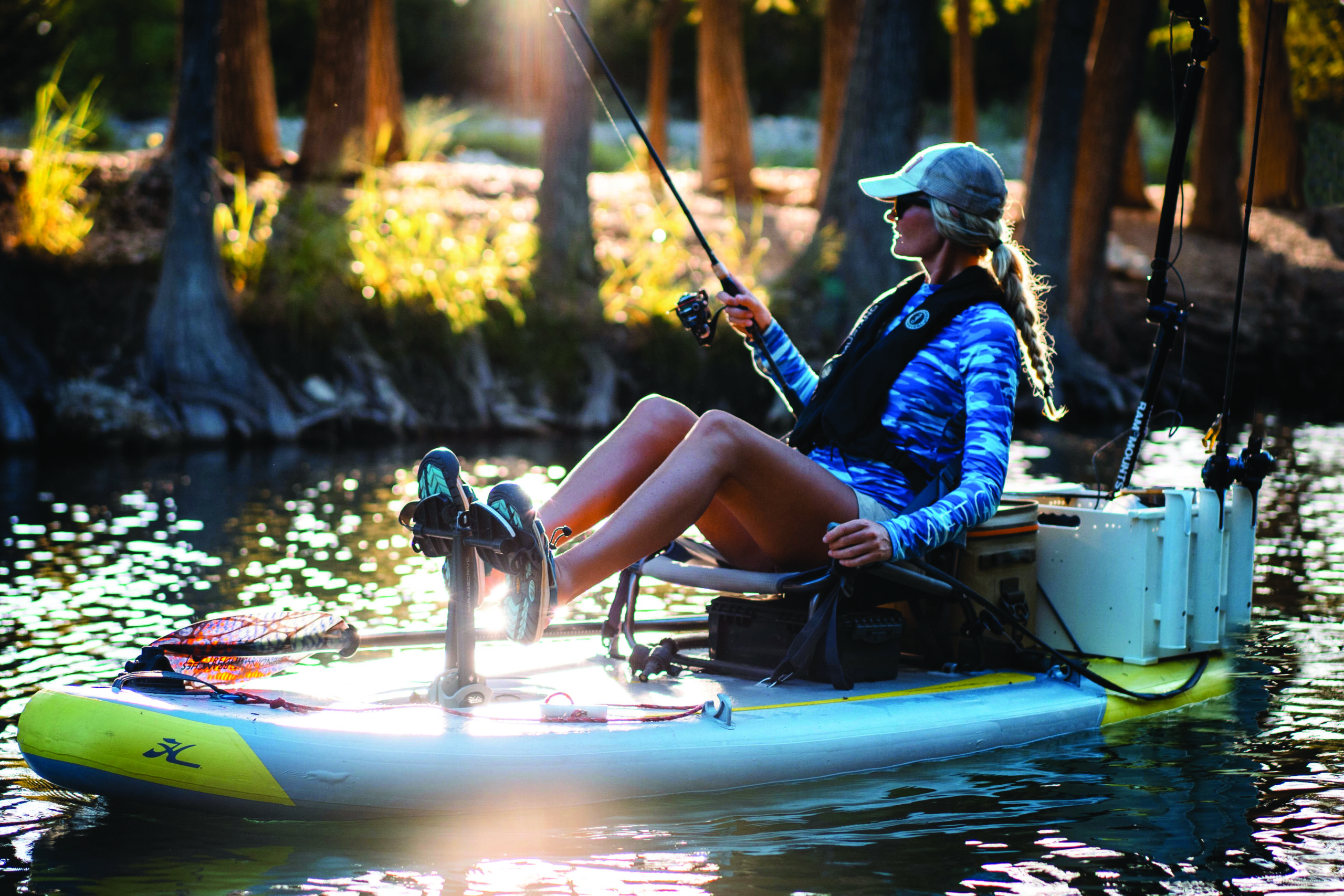
Among a fleet of fishing kayaks, Fischer’s favorite is her ITrek 11. “It’s essentially a stand-up paddle board with seat and pedal drive,” she says. “Totally stable and with a wide-open deck.” Anglers can fish all day from the comfortable raised seat on the stable platform while making use of Hobie’s Mirage Drive. Thanks to its design and minimal weight, the Trek 11 is amazingly nimble and quick with minimal effort. Fischer cites the low weight as an advantage for launching, especially when she launches off the side of a ravine into remote musky rivers.
Its weight makes it easy to maneuver around rivers and its stability assures secure stand-up fishing. When you’re done fishing it deflates to a small package. “It stores and travels so well. Since it comes in a ready-to-fly bag, adventure enthusiasts or tournament anglers can opt to fly anywhere with a great fishing platform,” she says. Adding that it’s also a great option for those traveling in RVs or small campers.
A key feature of Hobie’s inflatable is the Mirage drive, which increases speed and allows anglers to feather the blades in mere inches of water. A pedal drive is a unique feature on an inflatable, and a welcome luxury for anglers. Fischer relies on the electric pump to inflate her ITrek 11 almost instantly but says the hand pump can do the job in about 10 minutes. Adding electronics is not as simple as on most rigid kayaks, but Hobie offers an i-Series Fishfinder Install Kit.
Expert Tips: Take extra care when landing good fish, Fischer advises. “Without side rails on the ITrek, fish can more easily flop off the board than on a typical kayak,” she says. Also, make sure your H-Crate is fastened securely.
Best Motorized: Old Town Sportsman AutoPilot 120
Key Features
- Length: 12 feet
- Width: 37 inches
- Weight: 122 pounds (hull only). 153 pounds including accessories and motor.
- Capacity: 331 pounds.
- Spot-Lock
- 45 pounds of thrust
- Foot-brace steering
- Accessories: Four accessory tracks, four flush-mount rod holders, universal transducer mount, and through-hull wiring kits for electronics.
Pros
- Wireless, Bluetooth, GPS-enabled, reliable electric motor
- Stable for stand-up fishing
- Motor-driven prop cuts through vegetation more effectively than pedal drive
Cons
- Receptacle, where motor plugs in, may eventually require replacing
- A bit of a wet ride in a chop

Expert Profile: An author of fishing books and producer of YouTube fishing videos, John Skinner has been fishing from various sit-on-top kayaks since the 1990s. He targets stripers, fluke, weakfish, bluefish, and blackfish in the summer off Long Island in New York, and snook, redfish, tarpon, grouper, and sea trout in the winter months off southwest Florida. One of Skinner’s favorites in his fleet is the Old Town Sportsman AutoPilot 120. Arguably, the ultimate fishing kayak, the Sportsman AutoPilot 120, uses a trolling motor to take anglers to their spot and keep them there.
Skinner uses his AutoPilot 120 strictly for fishing and cites the Minn Kota motor’s superb autopilot and Spot-Lock features. He says it’s ideal for fishing shallows (often less than three feet) in Florida. “Off Long Island, it’s great to Spot-Lock over blackfish structure, or use in controlled drifts for fluke,” Skinner said. He added that with a good battery, the motor will run all day long and then some. He uses a 100 ah lithium-ion battery, which is much lighter than lead-acid.
“Its stability makes it extremely easy to stand and fish, and because the motor is controlled by a remote, you can stand while controlling propulsion and direction,” he says. While running from spot to spot, expect a top speed of just under 4 mph, Skinner says. If you fish skinny water, be prepared to break out the paddle and pull the motor. Skinner sometimes crosses flats with less than 15 inches of water, which is too shallow for the motor. “I also sometimes revert to paddling and poling for stealth when targeting redfish,” he said. But in deeper water, he found that Spot-Lock doesn’t necessarily spook fish like tarpon, as one might fear.
Skinner chose the Autopilot 120 over the 136 simply because it’s shorter and lighter, making it considerably easier to transport in his short-bed pickup with a bed extender or even on a vehicle roof.
Expert Tip: “When drift-fishing shallows or along mangrove shorelines, point your bow at the casting targets, and fish with your motor turned 180 degrees (reverse position) with a power setting of around 3. When you hook up, you’ll need only to turn the prop on to ‘backpedal’ on the fish and keep from being dragged onto the spot or into the mangroves,” Skinner said.
Best Tandem: Ocean Kayak Malibu Two XL
Key Features
- Length: 13 feet, 4 inches
- Width: 34 inches
- Weight: 70 pounds
- Capacity: 430 pounds
- Accessories: Two adjustable seat backs, overlapping foot wells, skid plates, option for two round Gaspachi hatches, side-mounted carrying handles, four colors
Pros
- Designed for single or double use
- Tremendous stability
Cons
- Limited storage space
Expert Profile: Tony Lai of Seminole, Florida, qualifies by any standard as a serious kayak enthusiast, and has won kayak fishing tournaments. But Lai’s entire family joins him much of the time on their kayaks in southwest Florida, whether on day trips or extended coastal camping adventures. The Lai family’s kayak of choice? The Ocean Kayak Malibu Two XL. Ocean Kayak makes some of the best fishing kayaks under $1,000 and this reasonably priced kayak has proven durable, versatile, and stable for two paddlers/anglers.
Lai cites what he calls a “perfect hull design” for a true family kayak. “It goes everywhere we want to take a day trip or a little adventure. It’s stable, tracks well, and handles great whether used in tandem or solo,” he says. Lai and his family have caught a great many fish from their XLs. Lai appreciates the opportunity it gives him to act as a guide, pointing out fish and positioning the kayak for the bow angler’s cast. Anyone who typically carries multiple kayaks on outings as Lai does, will appreciate the great stackability of the XL’s hull. But there is room for improvement. “The seats could use a little update,” he said.
The Malibu Two XL’s hull is made of high-density super-linear polyethylene; it includes a lifetime warranty. For its length and high capacity, 70 pounds is hardly an excessive hull weight, though some solo users may find it a bit heavy to lift. Serious anglers are likely to find the XL hull large and wide enough to stand in and fish from comfortably; however, there’s not much room for feet which can make this a bit tricky.
Expert Tips: Lai rigs his XLs with two flush-mount fishing-rod holders at the stern, plus four Scotty flush deck mount holders, two on each side of both paddlers. He has added an anchor trolley, and says little else is really needed for serious fishing. Lai reminds tandem users to always have the larger paddler in the stern for optimal stability and control (plus, there’s more room in the back).
Best for Inshore and Lake Fishing: Hobie Mirage Pro Angler 12 360
Key Features
- Length: 12 feet
- Width: 36 inches
- Weight: 109.5 pounds (hull only). 132.5 pounds fully rigged, including Mirage Drive
- Capacity: 500 pounds
- Accessories: MirageDrive 360 allows instant movement in any direction and spinning in its own length; Kick-Up Fins; six rod holders; adjustable Vantage ST seat with lumbar support; Guardian retractable transducer shield; H-Rails to integrate many accessories; easy-access front and center hatches; large standing area with EVA grip pads; two colors.
Pros
- 360 movement
- kick up fins
- rod holders
Cons
- Expensive
My keen love of kayak fishing and my occupation as a fishing editor/journalist have given me the opportunity to fish sit-on-top kayaks around the world, catching everything from bonefish to northern pike to striped marlin in most habitats imaginable. My kayak of choice? The Mirage Hobie Pro Angler 12 360. Arguably the most innovative fishing kayak, its features make this kayak a joy to fish from in all conditions.
Having fished from various sit-on-tops, none match the PA 12 360 for its performance, maneuverability, stability, and fishing features. The same kayak but with a 180 Mirage Drive (pedal unit that goes forward or backwards) will save you a grand, but I’ve discovered that if one can afford the extra thousand, the 360 drive is worth it. Once you’ve experienced the ability to have complete, total, and instant movement/control in any direction, you won’t want to give that up.
Among my favorite features are the rod holders: Four are horizontal in a way that protects the rods (even in the event of capsizing), keeping them out of the way yet immediately accessible. Two more are in-gunwale flush mounts, angled back. The rudder is under the hull, not at the stern where lines can tangle on it, and any resistance pushes it back up into its slot tucked into the hull, so forgetting to pull it up when you beach the PA 12 is no problem.
The Kick-Up Fins do their job, so when you whack them into logs or rocks, they bounce right back into position and keep going. The long H-Rails atop each gunwale offer a huge area for mounting electronics and accessories. An enormous front hatch with a removable liner and a large rectangular twist-and-seal hatch under my feet provide for generous stowage. The seat adjusts to keep me comfortable all day, and since I use it in the raised position, I can keep three Plano boxes full of lures underneath me, out of the way but instantly accessible.
While I’m not the steadiest angler when standing in a kayak, I do so comfortably—given calm water—in my PA 12 360, appreciating plenty of area for my feet. If you want even more kayak, look at the Pro Angler 14. For me, however, preferring to avoid a trailer, I find the PA 12 plenty of kayak and easily transported in the back of my long-bed F150.
Expert Tips: Use those H-Rails to mount forward rod holders. I put one Hobie H-Rail Rod Holder on each side just forward of amidships and use them constantly. Great for trolling. Also, learn to feather your pedals and, rather than holding your pedals flat against the hull and breaking out your paddle in skinny water, push yourself with surprising speed through shallow stretches.
Best for Rivers: Pyranha Fusion SOT
Key Features
- Length: 10 feet, 5 inches
- Width: 31 inches
- Weight: 56 pounds
- Capacity: 286 pounds
- Accessories: Drop-down skeg, rear hatch, optional storage pod, alum grab handles, two color choices
Pros
- Heavily rockered hull design
- Super-responsive performance
- Drop-down skeg
Cons
- Not ideal for serious fishing
Expert Profile: Kevin Whitley of Norfolk, Virginia, is a kayaking expert and Master Angler in Virginia. He’s been a committed kayak enthusiast for 20 years with several long-distance tours under his belt (longest: 1,800 miles from Pensacola, Florida, to Virginia in 4 ½ months), but in recent years has turned his attention to running rivers. When he’s running rivers his kayak of choice is the Pyranha Fusion SOT. The Fusion is a rarity among sit-on-top kayaks, purpose-designed and -built for fast water.
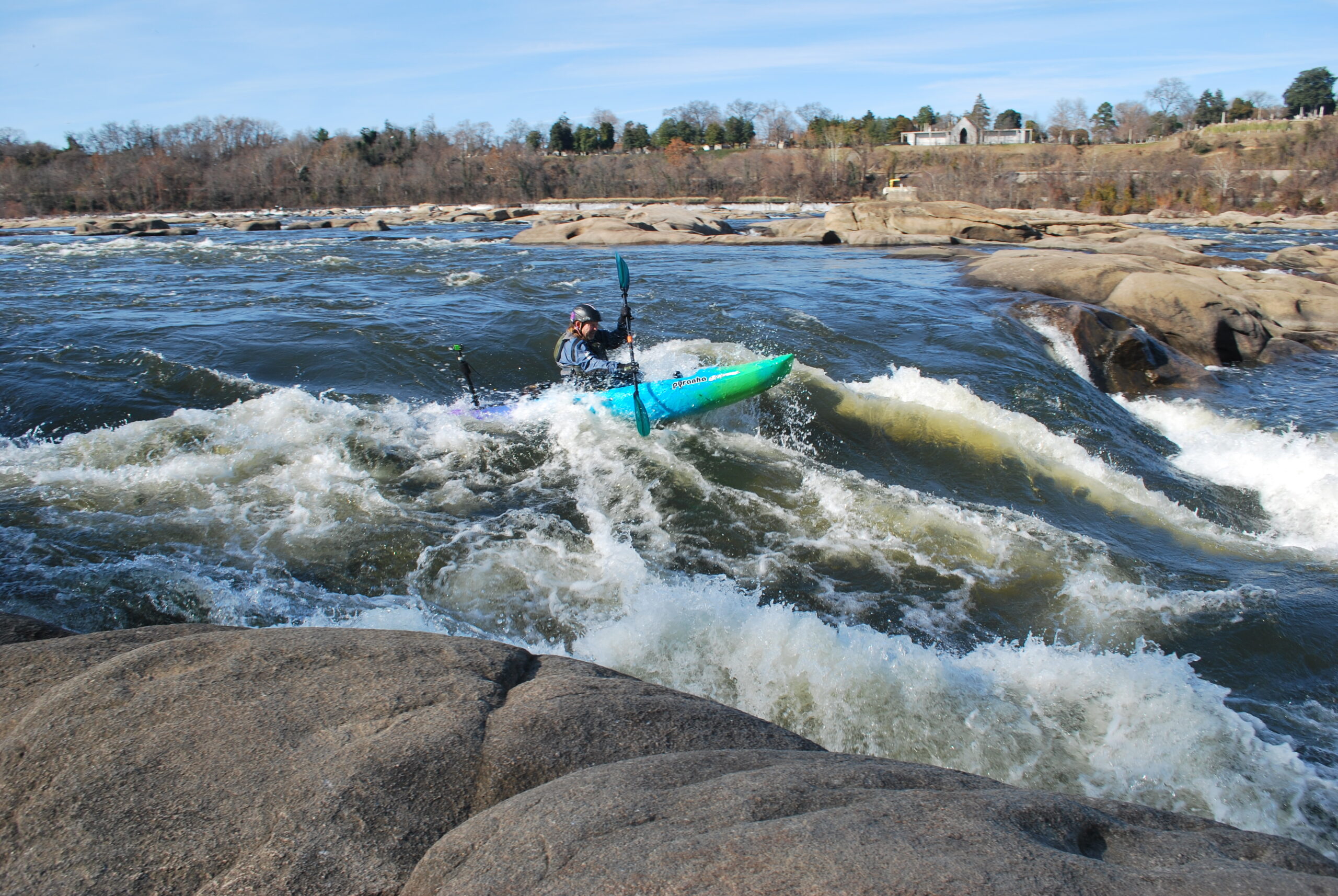
For the most part, running rivers is the domain of sit-inside kayaks. Most sit-on-tops are built for open water; to use them in serious white water would be at best difficult and, at worst, dangerous. Whitley says when he decided to start running rivers, after 20 years of riding on sit-on-top kayaks, he realized he was “too claustrophobic” to adapt to sit-insides. He found a solution in the Pyranha Fusion.
His fishing kayaks have keels that grab and are hard to control quickly. The Pyranha has no keels but rather what Whitley calls a “crazy rocker.” That means rather than a hull that’s flat along the bottom, the Pyranha’s super rocker accounts for great curvature in the hull bottom from amidships to the bow and to the stern (so both ends sit high off the ground). And that means it’s easy to lean hard, it spins on a dime, and slides quickly across the current, all responsive attributes that make the Pyranha Fusion a serious river runner—up to Class III, Whitley says.
The bottom line, the expert says, is simply that Fusion is a blast. The Pyranha’s hull is made of a “super linear HDPE” (low-density polyethylene) that the company calls MZ3, light in weight but with beefed-up durability and scratch resistance.
Expert Tips: Whitley says he keeps a Styrofoam wedge again the skeg on his Fusion to keep it solidly up when running rivers (he seldom needs the skeg). Also, he emphasizes the wisdom of using the provided thigh straps, which allow you to push down on one side while pulling up on the other side for sharper turns. “A lot of people don’t like ’em,” he says. “But they give you much more control and are really easy to get out of if you need to in a hurry.”
How I Evaluated the Best Sit-on-Top Kayaks
To review each of the best sit-on-top kayaks I went to experts in each category. Their extensive experience in a respective category gives credibility and weight to their opinions, upon which each elaborates and explains why he or she names a specific SOT as the best of the bunch. Here are the key aspects I evaluated for each kayak:
Old Town Sportsman Bigwater PDL
- Stability (can an angler stand and fish securely?)
- Maneuverability (anglers often encounter tight situations or require immediate directional control)
- Propulsion (hands-free fishing?)
- Comfort (suitable for sitting long hours?)
Hobie Mirage ITrek II
- Inflation (how quickly/easily accomplished?)
- Propulsion
- Stability
- Durability
Old Town Sportsman Autopilot 120
- Motor (efficiency, reliability)
- Technology (ability to find and hold to specific spots, coordinates)
- Stability (can an angler stand and fish securely?)
- Maneuverability (anglers often encounter tight situations or require immediate directional control)
- Propulsion (hands-free fishing?)
- Comfort (suitable for sitting long hours?)
Ocean Kayak Malibu Two XL
- Space for two (adequate, well-conceived?)
- Weight capacity (can it carry two large kayakers with no problem?)
- Hull weight (still easy to transport, launch?)
- Stability
Hobie Mirage Pro Angler 12 360
- Stability (can an angler stand and fish securely?)
- Maneuverability (anglers often encounter tight situations or require immediate directional control)
- Propulsion (hands-free fishing?)
- Comfort (suitable for sitting long hours?)
- Propulsion (how efficiently does Mirage Drive design perform?)
- Features (what does this kayak offer anglers that others don’t?)
Pyranha Fusion SOT
- How does this SOT’s design facilitate river running
- Maneuverability
- Stability
- Safety
- Durability.
FAQs
he key for choosing the best kayak for you is similar to choosing the best vehicle: Decide what you want to do with it — how you’ll use it. Some models, as this article shows, are best for very specific uses. Some might work well enough for multiple uses, depending upon what one plans to do. Generally, a bit of research will ensure you look at those kayaks best for your needs. Most manufacturers design various kayak models for particular uses. Compare those variables of particular importance to you, such as size, weight, propulsion, stability, features and so on.
With just a bit of practice, both sit-insides and sit-on-tops accessed pretty easily. Most often kayakers will hop in from shore or a dock. Either way, the critical consideration is where you put your weight. The more centered the better. Stepping or leaning too hard on one gunwale could capsize your kayak before you even get started. Getting in from a dock can be a bit trickier than from shore. With the kayak right next to the dock, keeping your butt on the dock, put both feet into the kayak, centered. Rotate (quickly, before the kayak can drift away from the dock) and drop right onto the seat, and you’re good to go. Coming back, reverse the process.
This, again, depends upon the kayaker and his/her preferences and needs. A sit-inside kayak is generally best for rivers or running whitewater. The kayaker sits lower (their center of gravity is actually a bit below water level), making it easier to stay upright. The enclosed cockpit allows him to instantly shift weight and slide his kayak in a way not possible on most sit-on-tops. And of course it’s much drier, a feature appealing where very cold conditions or lots of spray is involved.
But for more general use, and certainly for fishing, a sit-on-top offers many advantages including ease and simplicity. They tend to weigh more, with hulls that are wider, since the kayaker sits higher and needs a beamier hull to gain stability. But that same beamy hull means that in larger SOTs, anglers can easily stand and fish. The open design leaves the kayaker open to some spray but might be more comfortable for those who feel claustrophobic enclosed inside a small cockpit.
Final Thoughts
The popularity of sit-on-top kayaks has skyrocketed in recent years, and with good reason: They provide a relatively inexpensive means to access nearly any stream or body of water to which one can drive. The best sit-on-top kayaks all mean freedom to fish anywhere. Hop in and go. SOTs are generally light, durable, and great fun. Decide what you want to do with yours, then start researching. Odds are good you’ll find quite a few makes and models that will work for you.
- Best for Coastal and Open-Water Fishing: Old Town Sportsman Bigwater PDL
- Best Inflatable: Hobie Mirage ITrek II
- Best Motorized: Old Town Sportsman AutoPilot 120
- Best Tandem: Ocean Kayak Malibu Two XL
- Best for Inshore and Lake Fishing: Hobie Mirage Pro Angler 12 360
- Best for Rivers: Pyranha Fusion SOT
